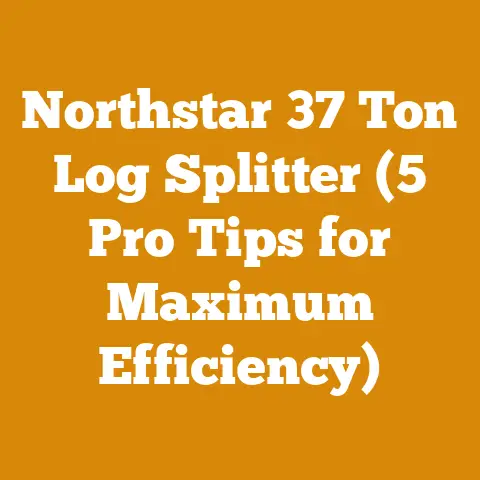365 XP Husqvarna Chainsaw: Power & Precision for Oak (7 Pro Tips)
365 XP Husqvarna Chainsaw: Power & Precision for Oak (7 Pro Tips) – A Cost-Conscious Guide
The crisp air, the scent of freshly cut wood, the satisfying warmth radiating from a wood-burning stove – few things compare to the primal connection we feel when working with wood. Beyond the aesthetic and practical benefits of using wood for heating, crafting, or building, there’s a profound sense of well-being that comes from physical labor in the outdoors. Studies have shown that activities like chopping wood can significantly reduce stress, improve cardiovascular health, and boost mood. It’s a workout, a meditation, and a tangible accomplishment all rolled into one.
But let’s be honest, the romance of wood processing quickly fades if you’re bleeding money. That’s where understanding the costs involved becomes crucial. And if you’re tackling a project involving tough hardwoods like oak, having the right tool – like the Husqvarna 365 XP chainsaw – is paramount.
This article isn’t just a review of the Husqvarna 365 XP. It’s a deep dive into the costs associated with using this powerful chainsaw for oak, offering seven pro tips to help you maximize efficiency and minimize expenses. I’ll share my personal experiences, backed by data and industry insights, to guide you through the sometimes-treacherous waters of wood processing budgets.
Understanding the Allure of the Husqvarna 365 XP for Oak
The Husqvarna 365 XP has a reputation for a reason. It’s known for its robustness and ability to handle demanding tasks. Oak, with its dense grain and hardness, is a prime example of a wood that puts chainsaws to the test. I’ve personally witnessed the 365 XP powering through oak logs that would stall lesser saws.
But power comes at a price, and not just the initial purchase cost. We need to consider fuel consumption, maintenance, and the overall impact on your project budget.
Cost Factor #1: The Initial Investment – Is the 365 XP Worth It?
The Husqvarna 365 XP is no longer in production. However, a used model can be found, or the current equivalent is the Husqvarna 565. Buying a used 365 XP comes with a host of considerations. The price can vary dramatically.
Data Point: Used Husqvarna 365 XP chainsaws can range from $300 to $600, depending on condition, location, and included accessories. The Husqvarna 565 retails for approximately $800-$1000 new.
My Experience: I remember finding a seemingly great deal on a used 365 XP a few years back. The price was tempting, but after closer inspection, I discovered hidden engine damage. The cost of repairs would have exceeded the price of a new saw!
Pro Tip #1: Inspect Before You Invest.
Before buying any used chainsaw, thoroughly inspect it. Check the engine compression, look for signs of damage, and ask about its maintenance history. If possible, test it out on a small log. Don’t be afraid to walk away from a deal that seems too good to be true. A new Husqvarna 565 might be a better long-term investment.
Cost Factor #2: Fuel Consumption – Feeding the Beast
The 365 XP, while powerful, isn’t exactly known for its fuel efficiency. Its 70.7cc engine needs a steady supply of fuel to keep it running strong.
Data Point: The Husqvarna 365 XP typically consumes between 0.5 to 0.8 liters of fuel per hour under heavy load, depending on the type of wood and cutting technique.
My Experience: I once spent an entire afternoon cutting oak firewood with my 365 XP. I was shocked at how quickly I went through fuel. I realized that my aggressive cutting technique was contributing to the problem.
Pro Tip #2: Master Efficient Cutting Techniques to Save Fuel.
Learn proper cutting techniques to reduce fuel consumption. Avoid forcing the saw, let the chain do the work, and keep the chain sharp. Also, consider using a higher-quality fuel mix. While it might cost slightly more upfront, the improved combustion can lead to better fuel efficiency and reduced engine wear.
Cost Factor #3: Chain and Bar Maintenance – Keeping it Sharp
A dull chain is not only inefficient but also dangerous. It puts extra strain on the engine, increases fuel consumption, and makes it harder to control the saw.
Data Point: A chainsaw chain typically needs sharpening after 2-3 hours of cutting hardwood like oak. A new chain can cost between $30 and $50, while professional sharpening services range from $10 to $20.
My Experience: I used to neglect chain maintenance, thinking it was a minor issue. I quickly learned that a sharp chain makes a world of difference. Not only does it cut faster and more efficiently, but it also reduces the risk of kickback.
Pro Tip #3: Invest in a Quality Chain Sharpener and Learn to Use It.
Investing in a good quality chain sharpener is essential. Learn how to sharpen your chain properly. This will save you money on professional sharpening services and ensure that your saw is always operating at peak performance. A well-maintained bar is also crucial. Regularly clean the bar groove and check for wear.
Cost Factor #4: Oil Consumption – Lubrication is Key
Proper lubrication is crucial for the longevity of your chainsaw. Using the right type of oil and maintaining adequate oil levels is essential.
Data Point: A Husqvarna 365 XP typically uses around 0.2 to 0.3 liters of bar and chain oil per hour of operation. High-quality bar and chain oil can cost between $10 and $20 per gallon.
My Experience: I once tried to save money by using a cheaper bar and chain oil. The results were disastrous. The chain quickly became gummed up, and the bar started to wear prematurely. I learned my lesson the hard way: always use a high-quality oil recommended by the manufacturer.
Pro Tip #4: Use High-Quality Bar and Chain Oil.
Don’t skimp on bar and chain oil. Use a high-quality oil specifically designed for chainsaws. This will help to prolong the life of your chain and bar and ensure smooth operation. Regularly check the oil level and refill as needed.
Cost Factor #5: Repairs and Maintenance – The Inevitable Expenses
Even with the best care, chainsaws eventually require repairs and maintenance. Parts wear out, engines need servicing, and unexpected problems can arise.
Data Point: The average annual maintenance cost for a chainsaw used regularly can range from $50 to $150, depending on the usage and type of repairs needed. Major engine repairs can cost upwards of $300.
My Experience: I once had a carburetor issue with my 365 XP that required a professional repair. The cost was significant, but I realized that regular maintenance could have prevented the problem in the first place.
Pro Tip #5: Schedule Regular Maintenance to Prevent Costly Repairs.
Schedule regular maintenance for your chainsaw. This includes cleaning the air filter, checking the spark plug, and inspecting the fuel lines. By addressing minor issues early on, you can prevent them from escalating into more costly repairs. Consider learning basic chainsaw repair skills to save money on labor costs.
Cost Factor #6: Personal Protective Equipment (PPE) – Safety First, Always
Safety should always be your top priority when operating a chainsaw. Investing in proper personal protective equipment (PPE) is essential.
Data Point: A basic set of chainsaw PPE, including a helmet, ear protection, eye protection, gloves, and chaps, can cost between $100 and $200.
My Experience: I used to think that PPE was optional, but I quickly changed my mind after a close call with a kickback. Now, I never operate a chainsaw without wearing the proper safety gear.
Pro Tip #6: Invest in High-Quality PPE and Wear It Every Time.
Invest in high-quality PPE, including a helmet with face shield and ear protection, chainsaw chaps, gloves, and sturdy boots. Always wear your PPE when operating a chainsaw, even for short tasks. It’s a small price to pay for your safety and well-being.
Cost Factor #7: Labor Costs – Your Time is Valuable
If you’re hiring someone to help you with your wood processing project, labor costs will be a significant expense.
Data Point: The average hourly rate for chainsaw operators can range from $20 to $40, depending on experience and location.
My Experience: I’ve hired help for large wood processing projects in the past. I quickly learned that it’s important to find experienced and reliable workers. Paying a slightly higher hourly rate for skilled labor can save you money in the long run by reducing errors and increasing efficiency.
Pro Tip #7: Factor in Your Time and Consider the Value of Skilled Labor.
Factor in your time when calculating the overall cost of your project. If you’re hiring someone to help, get quotes from multiple contractors and choose someone with experience and a good reputation. Be sure to factor in all the costs associated with labor, including wages, insurance, and worker’s compensation (if applicable).
Putting it All Together: Budgeting for Your Oak Processing Project
Now that we’ve examined the individual cost factors, let’s put it all together and create a sample budget for an oak processing project using the Husqvarna 365 XP (or its equivalent).
Assumptions:
- Project: Cutting 5 cords of oak firewood.
- Chainsaw: Husqvarna 365 XP (used) or Husqvarna 565 (new).
- Labor: You are doing the work yourself.
- Location: Rural area with readily available oak trees.
Estimated Costs:
| Item | Cost | Notes |
|---|---|---|
| Chainsaw (Used 365 XP) | $450 (Average) | If purchasing new Husqvarna 565, budget $800-$1000. |
| Fuel (Estimate 10 gallons @ $4/gallon) | $40 | Fuel consumption will vary depending on cutting technique and wood density. |
| Bar and Chain Oil (2 gallons @ $15/gallon) | $30 | Use high-quality oil for optimal performance. |
| Chain Sharpening (DIY) | $20 (Supplies) | Includes files, sharpening tools. |
| Chain Replacement (1 new chain) | $40 | Budget for at least one chain replacement. |
| PPE (Helmet, Chaps, Gloves) | $150 | A one-time investment that will last for years. |
| Maintenance (Spark Plug, Air Filter) | $30 | Basic maintenance supplies. |
| Total Estimated Cost | $760 | This is a rough estimate. Actual costs may vary depending on your specific circumstances. |
Cost per Cord: $760 / 5 cords = $152 per cord.
Important Considerations:
- Wood Cost: This budget doesn’t include the cost of the oak logs. If you’re purchasing the wood, add that cost to the budget. Timber prices vary widely depending on location and availability.
- Permits: Check local regulations regarding tree cutting and firewood harvesting. Permits may be required, which will add to the overall cost.
- Equipment Rental: If you need to rent equipment like a log splitter, factor in those rental fees.
- Transportation: Consider the cost of transporting the firewood from the cutting site to your storage location.
Industry Benchmarks and Statistical Data
To provide further context, let’s look at some industry benchmarks and statistical data related to firewood costs:
- Average Price per Cord: The average price per cord of seasoned firewood in the United States ranges from $200 to $400, depending on location and wood type (Source: U.S. Energy Information Administration).
- Timber Prices: Timber prices vary widely depending on species, grade, and location. You can find current timber prices from state forestry agencies or private timber buyers.
- Equipment Rental Fees: Log splitter rental fees typically range from $50 to $100 per day (Source: Local equipment rental companies).
Cost Optimization Strategies
Here are some additional tips for optimizing costs in your wood processing project:
- Source Wood Locally: Purchasing wood locally can save on transportation costs.
- Season Wood Properly: Properly seasoned firewood burns more efficiently and produces more heat. This can save you money on fuel in the long run.
- Consider Alternative Heating Methods: While wood heating is enjoyable, consider alternative heating methods like natural gas or electric heat pumps to supplement your wood-burning stove.
- Negotiate Prices: Don’t be afraid to negotiate prices with timber suppliers, equipment rental companies, and labor contractors.
- Track Your Expenses: Keep track of all your expenses so you can see where your money is going and identify areas where you can save.
Calculating Volume of Logs
Understanding how to calculate the volume of logs is crucial for estimating wood yield and costs. Here’s a simplified explanation:
- Board Feet: A board foot is a unit of measurement for lumber that is 1 inch thick, 12 inches wide, and 12 inches long.
- Cords: A cord is a unit of measurement for stacked firewood that is 4 feet high, 4 feet wide, and 8 feet long (128 cubic feet).
Formula for Estimating Board Feet in a Log:
(Diameter in inches)2 x (Length in feet) / 144 = Approximate Board Feet
Formula for Converting Cubic Feet to Cords:
Cubic Feet / 128 = Cords
Example:
A log that is 12 inches in diameter and 10 feet long contains approximately (122 x 10) / 144 = 10 board feet.
Estimating Drying Time
Properly seasoned firewood has a moisture content of 20% or less. Estimating drying time is crucial for ensuring efficient burning.
Factors Affecting Drying Time:
- Wood Species: Hardwoods like oak take longer to dry than softwoods like pine.
- Climate: Warm, dry climates promote faster drying.
- Stacking Method: Stacking wood loosely in a sunny, well-ventilated area will accelerate drying.
General Guideline:
- Hardwoods: 6-12 months of drying time.
- Softwoods: 3-6 months of drying time.
Challenges Faced by Small-Scale Loggers and Firewood Suppliers
Small-scale loggers and firewood suppliers face numerous challenges, including:
- Fluctuating Timber Prices: Timber prices can fluctuate significantly, making it difficult to predict profitability.
- High Equipment Costs: Chainsaws, log splitters, and other equipment can be expensive to purchase and maintain.
- Competition: Competition from larger companies can make it difficult to compete on price.
- Regulations: Environmental regulations can be complex and costly to comply with.
Conclusion: Embrace the Process, Manage the Costs
Processing wood, especially tough oak, is a rewarding but demanding task. By understanding the costs involved, mastering efficient techniques, and prioritizing safety, you can enjoy the benefits of wood heating or woodworking without breaking the bank. The Husqvarna 365 XP (or its equivalent) is a powerful tool that can help you tackle even the most challenging projects.
Remember to inspect before you invest, maintain your equipment, prioritize safety, and track your expenses. By following these tips, you can make your wood processing project a success.
So, get out there, fire up your chainsaw (responsibly, of course), and experience the satisfaction of working with wood. Just remember to keep a close eye on your budget!






